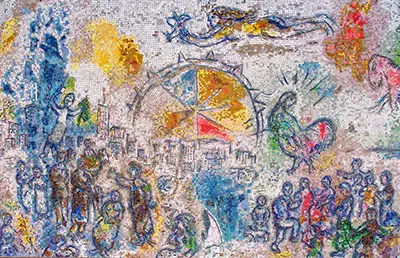The artist managed to find a way to make his dream-like worlds adaptable across a variety of different mediums. His lithographic prints were a direct extension of his skills with drawing and painting, but the mosaics would present him with more of a challenge. The artist spent the 1950s to 1970s trying out his first sculptures as well as a number of stained glass windows before eventually turning his hand to mosaics. Chagall would always call on the help of experienced artists when approaching new mediums in order to ensure the highest levels of quality possible, as well as to avoid having to sink huge amounts of time into understanding the technicalities of each and every new challenge. His reputation was already assured, and this allowed a greater flexibility with how he wanted to work - he was able to persuade patrons of the merits in allowing him to experiment with new ideas for their particular commissions.
There are many examples of famous artists who in their later years prefer to work on a smaller number of projects, but with each one being on a larger scale. For example, we are all aware of Joan Miro who produced some memorable sculptures after working for most of his career with painting and ceramics. These larger items could help to create a real legacy that would ensure the public would not forget their careers, and perhaps as they became older this was more of a pressing concern. Miro's Chicago and Dona i Ocell are two of the best examples of how that artist started to roll out much larger works. Chagall would go on a similar journey from approximately the 1960s, though he would still have other sidelines running at the same time. The US was showing a particular interest in his work and would start to offer some large commissions for artists such as Chagall in order to protect the future of various galleries and museums as well as in some cases to complement a private collection. Chagall liked to work from France and ship items over, but some mediums were better suited to this than others.
One of the artist's best known mosaics was known as Four Seasons. This project was designed within France, but the artist would then construct the arrangement of tiles once they had been sent over to the US. He would also make further amends by hand whilst there in order to finish the overall piece. This project would therefore involve some considerable logistical planning as well as the artistry itself, but Chagall was more than happy to allow good amounts of time for a well paying commission which also had the potential to strengthen his reputation within the US. At that time it is also important to remember that the US itself was starting to lead the international art world for the first time, having lived in the shadows of Europe for many centuries up to that point. Chagall understood this and wanted to be a part of its continued success even after his own career had come to and end. Whilst mosaic art is complex and somewhat fragile, Chagall would have found this process easier than when working with his extremely fragile stained glass windows.
This artist loved to make use of a large palette which allowed him to create finely balanced mosaics, where in between colours were present and the overall effect would be smaller. The downside would obviously be the intricacy of these complex arrangements that would then take much longer to formulate, though this was an artist who worked patiently in the latter part of his career and was more than happy to choose quality over speed. It is only when one views his mosaics up close do you see the amount of work that has been put in to create these various images. Something similar within the painting medium would be the Pointilist movement, where forms are put together using huge numbers of individual "points" or dots of paint. The master of this approach was Georges Seurat, who gifted us iconic artworks using this technique such as A Sunday Afternoon on the Island of La Grande Jatte and Bathers at Asnières. Chagall's mosaics would essentially swap the dabs of paint with individually coloured tiles.
